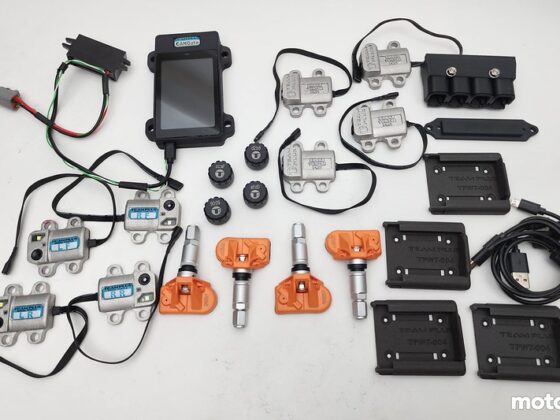
Once you have this mega fancy ABS system, you probably want to make a few other changes to make it work.
My SC300 is a 1992. It’s 30+ years old. I don’t know if the brake booster was the original or not, but replacement boosters are all remanufactured units at this point. Race cars probably should not be using vacuum-assisted brakes for various reasons. And, with turbo cars, you have problems generating vacuum anyway. The SC300 was a luxury car in the US, so it had fairly over-boosted brakes to give it a pleasant pedal feel. And, lastly, the OEM brake bias is whatever Toyota wanted it to be. There isn’t really a way to adjust front-rear bias on a factory master cylinder without adding a proportioning valve and all that can really do is reduce the amount of brake pressure that goes to the rear, which isn’t always optimal.
How do you fix all of these problems? You call up Kirk Skaufel from Tilton and tell him to fix it, you stroke another big check, and all this magical wonderful hardware shows up. Well, aside from that Monit bias adjuster which we’ll discuss later.
In Project SC300’s case, what showed up was an 850-series underfoot pedal assembly and appropriately-sized master cylinders, bias bar, and some other needed bells and whistles to make it all work. What other bells and whistles, you ask?
Very specifically: 79-series master cylinders. Why so specific? Because the 79-series master cylinders are designed for use with motorsport ABS systems. They have special cut-off ports with a compensation path that allows the master cylinder to handle the pulsation of fluid pressure caused when the ABS solenoid activates. If you use a regular non-specialized non-ABS master cylinder for your brakes, especially with a powerful system like the Bosch M5, you WILL destroy the seals in the brake master cylinders, and that will make for a very bad, messy day.
You’ll also want a fluid reservoir, and we opted for Tilton’s 4-AN plastic triple reservoir. And don’t forget the false floor kit so that everything looks pretty when you mount it to the floor.

One note on master cylinders – you have to choose the right size.
How does one choose the appropriate master cylinder size? Well, you talk to the experts. In this case, either Tilton or Stoptech.
Stoptech has this nifty form you can fill out and send to them that will help them determine the proper master cylinder sizes. There are a lot of factors that go into proper sizing. Tire type, certainly brake caliper specs, but also things like corner weights and center of gravity estimates all play a part. There’s a lot of race car engineer stuff that goes into it. Tilton has a similar form to fill out. Between the two companies, I settled on 7/10″ front and 13/16″ rear master cylinders, targeting a pedal effort of about 100lbs, which is medium racecar-ish. The 850-series pedal box also features an adjustable brake pedal ratio, which can be used (to some degree) to tune the pedal effort and pedal feel.
Now, let’s talk about floor mounting for a moment.

You have two choices for aftermarket pedal boxes. You can go with a floor-mount like I did, or you can go with a hung-mount pedal box. Most cars that are not German and built in the 80s have pedals that are hung from brackets on the firewall. This is what people are used to driving. However, my sim rig has had floor-mounted pedals for years, and I wanted my sim setup to be close to my real car. I also knew that the factory cross-bar is still in the car under the dash and would change someday if I ever re-did the cage, so I didn’t want to invest in fabrication that would just get tossed later (avoiding doing it twice). So I went the floor-mounted route.
As you can see, the floor of the SC300 is decidedly not flat. The pedal box can’t just bolt directly to the floor. OK, you could have made some ugly risers and bolted it to the floor, but the floor is kinda flexy and not really designed to handle pedals like that. Toyota designed the firewall for that.
The right way to do this, as you can see, is to fabricate a strong bracket that is tied into the chassis at multiple points, and then bolt the pedal box to that.




7 comments
Hi,
Continental who own Teves make a MK100 motor sport ABS system. It’s been around for about 2y now so you can buy new. It also comes with user adjustable software unlike the BOSCH M5
I had found the Continental system when I was poking around. The main challenges with a system like that are things like the dealer network, people’s familiarity with the systems, etc. Bosch has a huge booth at PRI every year. I’ve never seen Continental/Teves. Ed Senf, who is my tuner, is also my Bosch dealer. I don’t know any Continental dealers, and Ed had never seen one of those systems.
Just last week, another system was also announced/introduced: Delta ABS.
Where do you plan on racing this thing? Is it for time attack?
The car is currently built to be compatible with NASA’s SuperTouring ruleset. With its current power-to-weight ratio, it fits into ST2.
I ran one #GRIDLIFE TT with it back at NCM in 2021, I think. I would have run a Global Time Attack at Road Atlanta, but they had a Yokohama tire requirement, and I didn’t want to purchase tires just for that one event, although I think they’ve relaxed that requirement.
Hi Erik,
Great read.
Glad to see you and the car back.
Looking forward to the next update
Glad to be back!
Your documentation and insight into this build has been very valuable in my own SC300 build. I appreciate every one and part 36 was worth the wait.